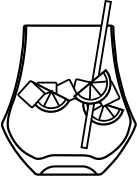
Subscribe to our mailing list and receive our latest news, events and product information.
John Jarvis is a legend in the modern world of Tasmanian Whisky. Apart from being the main man running the ship at Hobart Whisky, he somehow finds time to make knives from scratch. Like proper scratch. Like actually forging the blades. Crikey. John only makes to order under the banner of "Whisky and Blade" and as we like to support the doers, we had to have a set for ourselves. Here is the story in John’s own words.
These are the largest blades that I have ever forged. A blade edge of about 9.5 inches, someone commented that the photos don’t show the sheer size of the knives.
 |

|
Started by tack welding a stack of carbon steel, 1084 and 15N20, with a portion of mild steel from an exhausted Hobart Whisky cask hoop.
 |

|
Took this to the forge and started forge welding it together by heating and hammering. One I was sure it was a single billet, I started drawing out the billet in to a bar, and repeated this process several times.
Given the size of my forge, the size of the blades, and fact there was a pair, I made large, oversized billets with the intention of having plenty of leeway to grind away metal to make sure I could make the knife pair the same.
Once I had both billets large enough, and drawn out to the rough shape, I started grinding the knife profile. It’s easier to do this before we harden the knife as the metal is still easy to work with and puts less strain on the grinder and belts. I actually like to get the knife as close to the final profile and rough bevels in before heat treatment for this reason.

|
Following this the blades are taken to heat treat temperature and quenched, hardening the blade.
The blades are then gently sanded and cleaned up before being tempered for four hours. Tempering is done to ensure the blades aren’t brittle and break if dropped/knocked.
 |

|
Back on to the grinder now where the blades are cleaned up further, bevels are cleaned up and refined.
Then I start hand sanding the blades, working my way through different grit sandpaper. I often like to retain some of the original characteristics of the forging process in the blades so it’s common to see my knives with forging marks/patterns.
 |

|
The handle is made with Tasmanian Blackheart Sassafras, copper spacers and pins.
It’s cut, drilled, fit up, epoxied, and clamped to dry.

|
Once fit up, it’s put on the belt grinder again and sanded to shape, being sure to make sure it’s comfortable and there are no sharp edges.
The handle is hand sanded once completed and stained with a water-based sealer.

|
At this point I sand the blade again with a fine grit sandpaper, just to ensure it’s consistent and clean.
 |

|
Knife numbers five and six, etched with the Whisky and Blade mark and corresponding numbers.
JJ

|
Note: We’re chuffed and blown away by our one handed axes, ahem knives. The craft is beautiful and that detail of the whisky glass in the blades is just awesome. We will have these for life.

|